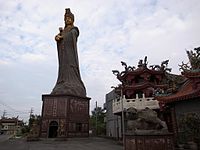Xinwu Tianhou Temple
| Xinwu Tianhou Temple | |||||||||
|---|---|---|---|---|---|---|---|---|---|
 Entrance | |||||||||
| Traditional Chinese | 天后宮 | ||||||||
| Simplified Chinese | 天后宫 | ||||||||
| Literal meaning | Heavenly Empress Palace | ||||||||
| |||||||||

The Tianhou[1] or Mazu Temple[2] is a temple to the Chinese sea goddess Mazu, the deified form of Lin Moniang, a medieval Fujianese shamaness. It is located in Taoyuan's Xinwu District on Taiwan, southwest of Taipei.
History
The area of Xinwu was settled by Mazu-worshipping Fujianese immigrants during the mid-18th century, the Qianlong Era of the Qing dynasty. The Tianhou Temple was established in 1826 (the sixth year of Qing's Daoguang Era), with its location supposedly pointed out by the goddess. Its idol came from the Chaotian Temple in Beigang. The original small mud structure[1] has since been rebuilt or renovated in 1878, 1905, 1957, 1984, and 2002.[2]
The bronze statue of Mazu was erected in 2002. It is 32.7 meters (107 ft) high and 72 tons in weight.[1] It is protected by smaller statues of Mazu's door gods and guardians Qianliyan and Shunfeng'er.[2] It is the 2nd-tallest statue of Mazu on Taiwan and the 3rd-tallest in the world.
See also
References
Citations
Bibliography
- "Corporation Tianhou Temple" Historical Marker, Xinwu: Taoyuan County Government, 2006. Template:Zh icon & Template:En icon
External links
- Official site, Xinwu: Sinwu Mazu Temple, 2013.
- Photographs of the statue and temple in 2010 by Josh Fahler
